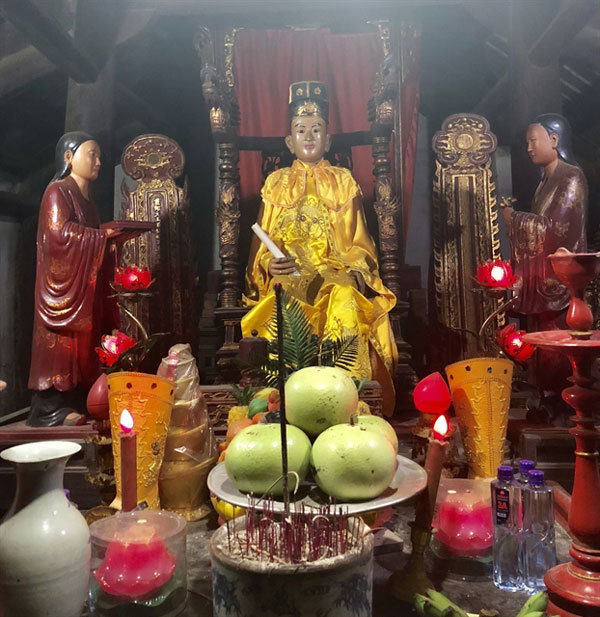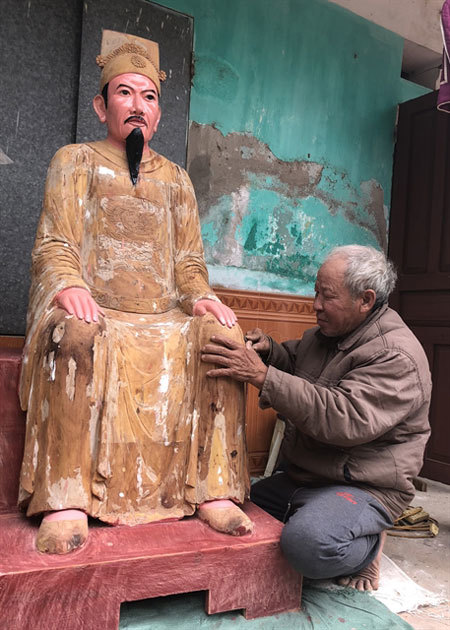A visit to Bao Ha statue-making village
Farmers breathe new life into puppetry art
 |
| The ancient statue of Linh Lang Dai Vuong can stand up from its seated position thanks to a hidden system of bars and rollers connected to the temple door. |
What is so unusual about this ancient work of art? The lifelike sculpture can sit down and stand up.
When the door of the temple is opened, the sculpture gradually stands from its perch on top of a throne at the altar before retaking its seat.
Temple caretaker Pham Trong Yem, 81, explained the secret: when the statue was first built, talented artisans in the village, which has long been famed for its wood carving, created a system of moving rollers under the altar.
Bars attached to the door move the mechanism when the door opens and closes, which in turn makes the sculpture stand.
“Besides, the sculpture was also made with the moving joints of a puppet,” he said.
Though the movements of the sculpture depend on the movements of the temple door, not everyone can make it happen.
Yem said only temple caretakers who understand the secret have the ability to move the sculpture smoothly.
The rare sculpture has brought attention to the thousand-year-old temple, which was recognised as a National Relic site in 1991.
The sculpture depicts Linh Lang Dai Vuong, the village’s genie, who has been worshipped at the temple for centuries.
Legend says he was Prince Hoang Chan, a son of King Ly Thanh Tong (1023-1072). When the Chinese Song troops invaded the country, the prince built an army stronghold at the site to defend against the invaders.
When he passed away, locals made a sculpture of him and placed it in a temple on the very army station.
Seven hundred years ago, artisans created the sculpture we see today to replace the original.
The temple is also dedicated to Nguyen Cong Hue, the ancestor of the sculpture-making craft. He passed the craft down to locals, who have maintained the tradition to this day to earn a stable living.
In the early 15th century, when Vietnam was ruled by the Chinese Ming Dynasty, Hue was forced to work as a servant in China.
There he attentively studied the craft of carving wooden sculptures, lacquer and acupuncture.
When he returned home, he taught the techniques to locals, who then handed them down to the next generations.
Bao Ha Village has long been famous for its talented artisans, who made many of the wooden statues seen at pagodas and temples throughout the country.
There are 200 households still practising wood carving in the village. They have created a diverse range of products including statues of the Buddha and various saints, and worship objects sold on the domestic market and exported overseas.
 |
| Do Buong at work. The respected artisan cannot remember how many statues he has made during his long career. VNS Photos Tran Mai Huong |
Do Buong, 70, is a well-known artisan in the commune. He has spent his whole life perfecting the craft.
He cannot remember how many unique sculptures he has made to meet customers’ demands. His house is full of unfinished sculptures.
“We have lived on the handicraft that our ancestors handed down,” he said. “My parents have asked me – and I will also ask my children and grandchildren – not to forget the ancestor of the career, who first brought the skills here and taught our great grandparents.”
“We will continue to pass the skills down so that the career is maintained forever.”
Buong’s house is located not far from the temple. On the short trip across the village, the sounds of wood carving echo from the houses.
Buong's deep respect and gratitude for local history is shared by his peers – the same respect that led artisans in the village to create the sculpture of Linh Lang Dai Vuong 700 years ago. VNS
Tran Mai Huong
 Seven-hundred years after it was constructed, a sculpture continues to surprise visitors to Bao Ha Temple in Bao Ha Village, Dong Minh Commune, Vinh Bao District in the port city of Hai Phong.
Seven-hundred years after it was constructed, a sculpture continues to surprise visitors to Bao Ha Temple in Bao Ha Village, Dong Minh Commune, Vinh Bao District in the port city of Hai Phong.